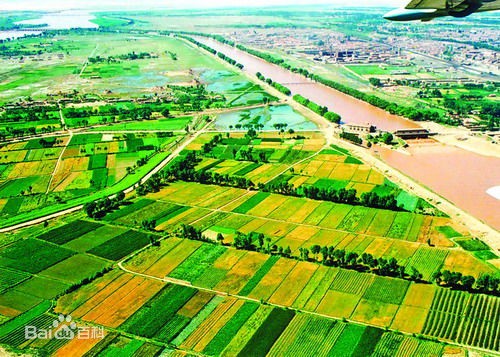As the sensitive areas of global climate change, Yellow River basin, situated in arid and semiarid regions, also plays an important role in food production. However, using water resources in the Yellow River basin is challenging due to the drought and increasing water consumption.
“The large-scale agricultural irrigation is an important process in the utilization of water resources in Yellow River basin.” Says Dr. CHEN Liang, an assistant researcher in the Institute of Atmospheric Physics/Chinese Academy of Sciences and also the first author of a paper recently published in Atmospheric and Oceanic Science Letters, “The agricultural irrigation affects the regional climate mainly through changing the surface water process. There have been studies on climate change effect incurred by the change of the soil moisture, but the role of irrigation has not been sufficiently depicted in those studies. “

Fig. 1. Irrigation in Hetao (middle section of Yellow River, image from Baidu Baike)
CHEN and his team developed a new irrigation scheme based on the Noah land surface model, and then coupled it with the Weather Research and Forecasting regional climate model. Two simulations (with and without irrigation) were conducted over the Yellow River basin for the period April to October 2000–2010.
The results indicated that when irrigation was induced, the mean surface air temperature decreased, and there was a correspond increase (decrease) in latent (sensible) heat flux over the irrigated areas. The cooling effect was consistent with the changes in evapotranspiration and heat fluxes due to irrigation. The agriculture irrigation will lead to a greater probability of cloud formation which then impacted the spatial distribution of surface sir temperature and precipitation.

Fig. 2.Three-month (June–August) mean SH (sensible heat flux; units: W m−2) and LH (latent heat flux; units: W m−2) during 2001–10, and their differences between the simulation with irrigation (IRR) and the control run (CTL): (a) SH in CTL; (b) SH in IRR; (c) SH difference between IRR and CTL; (d) LH in CTL; (e) LH in IRR; (f) LH difference between IRR and CTL. (Chen et al., 2017)
“These studies will provide science advice to water use sustainable development in Yellow River basin.” CHEN concludes, “In the future, we would like to use different irrigation method to asses the impact of irrigation on regional climate and hydrologic cycles. “
Citation: CHEN Liang, MA Zhu-Guo, ZHAO Tian-Bao, LI Zhen-Hua and LI Yan-Ping, 2017: Simulation of the regional climatic effect of irrigation over the Yellow River Basin, Atmospheric and Oceanic Science Letters. doi:10.1080/16742834.2017.1313681.
Link: http://www.tandfonline.com/doi/abs/10.10806742834.2017.1313681
Contact: CHEN Liang, chenliang@tea.ac.cn
